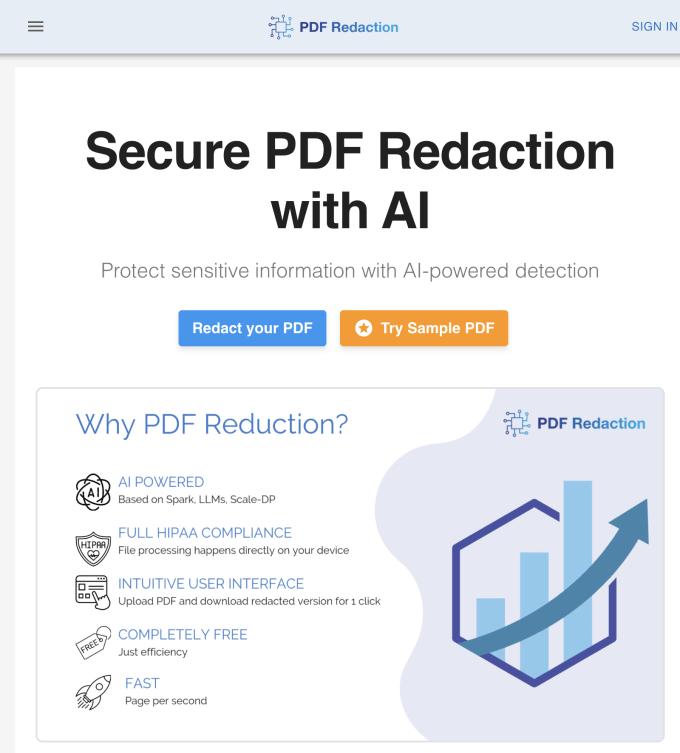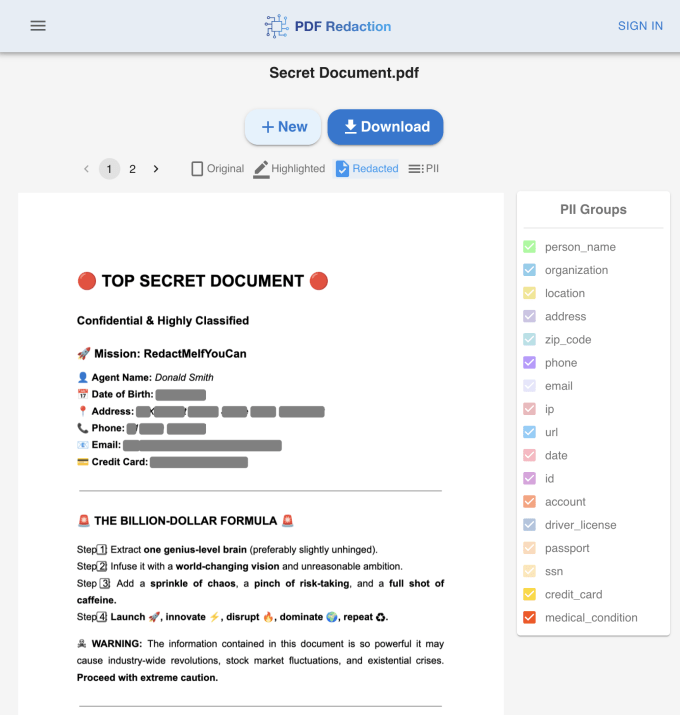The Importance of PDF Redaction
Protecting Sensitive Information
PDF redaction is essential for safeguarding confidential business information, such as trade secrets, financial data, and personal identifiers. Improper handling of sensitive data can lead to identity theft, corporate espionage, or reputational damage, potentially costing organizations millions of dollars. For instance, the average cost of a data breach reached $4.45 million in 2023. Proper redaction ensures that critical details are permanently removed, preventing unauthorized access and misuse.
PDF Redaction Service

PDF-Redaction.com offers a comprehensive solution for organizations seeking efficient and secure document redaction. Their cloud-based platform combines advanced AI technology with user-friendly interfaces, allowing users to automatically detect and permanently remove sensitive information from PDFs with just a few clicks. The service excels at identifying common PII patterns such as social security numbers, credit card information, and medical record identifiers, while also allowing for custom redaction rules tailored to specific industry needs. With features including batch processing capabilities, metadata scrubbing, and detailed audit logs for compliance documentation, PDF-Redaction.com provides enterprise-grade security without requiring software installation or extensive training.

Here you can spot an example of how it works.
Ensuring Legal and Regulatory Compliance
Businesses must comply with data protection regulations such as the General Data Protection Regulation (GDPR) and the Health Insurance Portability and Accountability Act (HIPAA). These laws mandate the secure handling of sensitive information to protect privacy and prevent data breaches. Failure to comply with these regulations can result in severe penalties and legal consequences.
Maintaining Business Reputation
The exposure of sensitive data can significantly harm an organization’s reputation, making it difficult to regain public trust. Proper redaction helps businesses maintain their credibility by ensuring that confidential information remains secure during document sharing or publication.
Everyday Use Cases for PDF Redaction
Legal Industry
Attorneys often redact client names, addresses, and privileged communications before filing court documents. This ensures compliance with legal procedures and protects client confidentiality.
Financial Sector
Financial institutions redact account numbers, transaction details, and other sensitive information when sharing reports with third parties. This prevents unauthorized access to financial data and ensures compliance with industry regulations.
Healthcare Industry
Healthcare organizations redact patient information from medical records to comply with HIPAA and other privacy regulations. This practice protects patient confidentiality and prevents potential misuse of sensitive health data.
Corporate Sector
Businesses redact trade secrets, proprietary information, and intellectual property when sharing documents externally. This prevents competitors from gaining access to valuable business insights.
Risks of Improper Redaction
Hidden Information Left Behind
Redacted documents may still contain sensitive information in metadata or hidden layers. Failing to sanitize these elements can expose critical data.
Inconsistent Redaction Processes
Manually redacting documents can lead to inconsistencies, where some sensitive data remains visible. Standardizing the redaction process with automated tools helps maintain thoroughness.
Using Insecure Methods
Methods such as covering text with black boxes or changing the text color to match the background are not secure. These techniques do not remove the underlying data, making it possible to recover the redacted information.
Best Practices for Secure PDF Redaction
Use Reliable Redaction Tools
Choose trusted redaction tools that permanently remove sensitive information. Tools like Adobe Acrobat, Facit, and Redactable offer robust redaction features, including metadata removal and batch processing.
Double-Check Redacted Files
Before sharing a redacted document, verify that all sensitive information has been completely removed. Open the document in different viewers, attempt to search for redacted content, and check if it can still be copied or extracted.
Remove Metadata and Hidden Layers
Metadata, comments, and revision histories can contain sensitive information. Use redaction tools to sanitize the document by removing hidden content.
Create Backups
Always save a copy of the original document before applying redactions. This ensures that you have a backup in case of errors.
Train Staff on Redaction Techniques
Educate employees on secure redaction methods to ensure consistency and prevent errors. Proper training minimizes the risk of accidental data exposure.
Tools for PDF Redaction
Adobe Acrobat Pro
Adobe Acrobat Pro is a leading PDF editor and redactor, offering comprehensive features such as metadata removal and secure redaction. However, it requires installation and is relatively expensive.
Redactable
Redactable is an AI-powered redaction tool that automates the process of detecting and removing sensitive information. Its cloud-based platform supports batch processing and complies with GDPR and other privacy regulations.
Facit
Facit’s redaction software includes features such as metadata cleaning and automated redaction. It simplifies compliance with data privacy regulations and ensures complete security.
Free PDF Redactor
This online tool is a cost-effective option for basic redaction needs. It ensures that redacted information cannot be recovered but lacks advanced features such as metadata removal.
Conclusion
PDF redaction is a critical practice for protecting business secrets and ensuring compliance with data privacy regulations. By adopting secure redaction methods, using reliable tools, and following best practices, businesses can safeguard sensitive information and minimize the risk of data breaches. As the digital landscape continues to evolve, organizations must prioritize document security to maintain trust, protect their reputation, and comply with legal requirements. Investing in proper redaction techniques is not just a necessity—it’s a strategic imperative for long-term success.
Let’s wrap up with a revelation that struck me recently: mastering PDF redaction is much like ensuring that the locks on your house are robust before you leave for a vacation. The peace of mind that comes from knowing your secrets (and valuables) are safe is priceless. But, I’m still trying to figure out the best way to convey this to everyone at work without sounding too pedantic.

